



An executioner, also known as a hangman or headsman, is an official who effects a sentence of capital punishment on a legally condemned person.




An executioner, also known as a hangman or headsman, is an official who effects a sentence of capital punishment on a legally condemned person.
The executioner was usually presented with a warrant authorising or ordering him to execute the sentence. The warrant protects the executioner from the charge of murder. Common terms for executioners derived from forms of capital punishment—though they often also performed other physical punishments—include hangman (hanging) and headsman (beheading). In the military, the role of executioner was performed by a soldier, such as the provost. A common stereotype of an executioner is a hooded medieval or absolutist executioner. Symbolic or real, executioners were rarely hooded, and not robed in all black; hoods were only used if an executioner's identity and anonymity were to be preserved from the public. As Hilary Mantel noted in her 2018 Reith Lectures, "Why would an executioner wear a mask? Everybody knew who he was".
While this task can be occasional in nature, it can be carried out in the line of more general duty by an officer of the court, the police, prison staff, or even the military. A special case is the tradition of the Roman fustuarium, continued in forms of running the gauntlet, where the culprit receives their punishment from the hands of the comrades gravely harmed by their crime, e.g. for failing in vital sentinel duty or stealing from a ship's limited food supply.
Many executioners were professional specialists who traveled a circuit or region performing their duty, because executions were rarely very numerous. Within this region, a resident executioner would also administer non-lethal physical punishments, or apply torture. In medieval Europe, to the end of the early modern period, executioners were often knackers, [1] since pay from the rare executions was not enough to live off.
In medieval Europe executioners also taxed lepers and prostitutes, and controlled gaming houses. They were also in charge of the latrines and cesspools, and disposing of animal carcasses. [2]
The term is extended to administrators of severe physical punishment that is not prescribed to kill, but which may result in death.
Executions in France (using the guillotine since the French Revolution) persisted until 1977, and the French Republic had an official executioner; the last one, Marcel Chevalier, served until the formal abolition of capital punishment in 1981. [3]
In Western Europe and its colonies, executioners were often shunned by their neighbours, with their work as knackers also disreputable. [1] In Alexandre Dumas' The Three Musketeers and in the film La veuve de Saint-Pierre (The Widow of Saint-Peter), minor character executioners are ostracized by the villagers.
The profession of executioner sometimes ran through a family, especially in France, where the Sanson family provided six executioners between 1688 and 1847 and the Deibler dynasty provided five between 1879 and its 1981 abolition. The latter's members included Louis Deibler, his son Anatole, Anatole's nephew Jules-Henri Desfourneaux, his other nephew André Obrecht, and André's nephew Marcel Chevalier. [4]
In Britain, the most notable dynasty was the Pierrepoints, who provided three executioners between 1902 and 1956 – Henry, his brother Thomas, and Henry's son Albert. Unlike in France and many other European countries, far from being shunned, British executioners such as William Marwood, James Berry, Albert Pierrepoint, and Harry Allen were widely known and respected by the public.
In Japan, executioners have been held in contempt as part of the burakumin class (today executions in Japan are not carried out by professional executioners, but by prison guards). In Memories of Silk and Straw, by Junichi Saga, one of the families surveyed in the Japanese village of Tsuchiura is that of an executioner family ("The Last Executioner", p. 54). This family does suffer social isolation, even though the family is somewhat well-off financially.
In the Ottoman Empire, only Romani could be executioners. Executioners were seen as "damned" people and even their graveyards were separate from public graveyards. There were no inscriptions on executioner tombstones, and usually uncarved and unpolished simple rough stones were used. One of the oldest and largest "executioner graveyards" is in the Eyüp district in Istanbul. After the republican revolution in Turkey, executions continued to be performed by Romani executioners. This situation continued until the abolition of capital punishment in Turkey.
The town of Roscommon has the distinction of having had Ireland's most notorious hangwoman, Lady Betty, who was given the post in exchange for her life being spared when the hangman due to execute her death sentence took ill on the day that she and 25 others were due to be hanged. Lady Betty offered to carry out the task in exchange for her death sentence being commuted to a life sentence, and she acted as the county's hangwoman from then on. [5] An unidentified woman hanged two men for murder on 13 November 1782 at Kilmainham, near Dublin. The men were also quartered. The sheriff received abuse for making a hangman of a woman. [6]
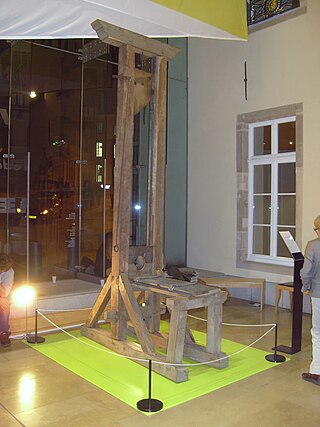
A guillotine is an apparatus designed for efficiently carrying out executions by beheading. The device consists of a tall, upright frame with a weighted and angled blade suspended at the top. The condemned person is secured with a pillory at the bottom of the frame, holding the position of the neck directly below the blade. The blade is then released, swiftly and forcefully decapitating the victim with a single, clean pass; the head falls into a basket or other receptacle below.

Decapitation is the total separation of the head from the body. Such an injury is inevitably fatal to humans and most other animals, since it deprives the brain of oxygenated blood, while all other organs are deprived of the involuntary functions that are needed for the body to function.
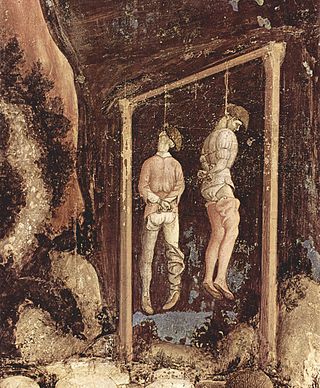
Hanging is killing a person by suspending them from the neck with a noose or ligature. Hanging has been a common method of capital punishment since the Middle Ages, and is the primary execution method in numerous countries and regions. The first known account of execution by hanging is in Homer's Odyssey. Hanging is also a method of suicide.

Albert Pierrepoint was an English hangman who executed between 435 and 600 people in a 25-year career that ended in 1956. His father Henry and uncle Thomas were official hangmen before him.
Harry Bernard Allen was one of Britain's last official executioners, officiating between 1941 and 1964. He was chief executioner at 41 executions and acted as assistant executioner at 53 others, at various prisons in England, Scotland, Northern Ireland, the Channel Islands and Cyprus. He acted as assistant executioner for 14 years, mostly to Albert Pierrepoint from 1941 to 1955.

Hamida Djandoubi was a Tunisian convicted murderer sentenced to death in France. He moved to Marseille in 1968, and six years later he kidnapped, tortured, and murdered 22-year-old Élisabeth Bousquet. He was sentenced to death in February 1977 and executed by guillotine in September that year. He was the last person to be executed in Western Europe, and also the last person to be lawfully executed by beheading anywhere in the Western world, although he was not the last person sentenced to death in France. Marcel Chevalier served as chief executioner.
Marcel Chevalier worked as the last chief executioner in France.
Capital punishment in Canada dates back to Canada's earliest history, including its period as a French colony and, after 1763, its time as a British colony. From 1867 to the elimination of the death penalty for murder on July 26, 1976, 1,481 people had been sentenced to death, and 710 had been executed. Of those executed, 697 were men and 13 were women. The only method used in Canada for capital punishment of civilians after the end of the French regime was hanging. The last execution in Canada was the double hanging of Arthur Lucas and Ronald Turpin on December 11, 1962, at Toronto's Don Jail. The military prescribed firing squad as the method of execution until 1999, although no military executions had been carried out since 1946.
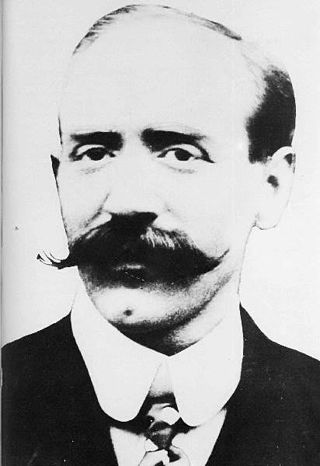
John Ellis was a British executioner for 23 years, from 1901 to 1924. His other occupations were as a Rochdale hairdresser and newsagent.
Thomas William Pierrepoint was an English executioner from 1906 until 1946. He was the brother of Henry Pierrepoint and uncle of Albert Pierrepoint.

Capital punishment in France is banned by Article 66-1 of the Constitution of the French Republic, voted as a constitutional amendment by the Congress of the French Parliament on 19 February 2007 and simply stating "No one can be sentenced to the death penalty". The death penalty was already declared illegal on 9 October 1981 when President François Mitterrand signed a law prohibiting the judicial system from using it and commuting the sentences of the seven people on death row to life imprisonment. The last execution took place by guillotine, being the main legal method since the French Revolution; Hamida Djandoubi, a Tunisian citizen convicted of torture and murder on French soil, who was put to death in September 1977 in Marseille.

André Obrecht was the official executioner of France from 1951 until 1976.
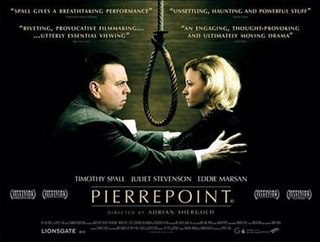
Pierrepoint is a 2005 British film directed by Adrian Shergold about the life of British executioner Albert Pierrepoint.

Capital punishment in Sweden was last used in 1910, though it remained a legal sentence for at least some crimes until 1973. It is now outlawed by the Swedish Constitution, which states that capital punishment, corporal punishment, and torture are strictly prohibited. At the time of the abolition of the death penalty in Sweden, the legal method of execution was beheading.
Johann Reichhart was a German state-appointed judicial executioner in Bavaria from 1924 to 1946. During the Nazi period, he executed numerous people who were sentenced to death for their resistance to the German government. After the war, he was employed as executioner by the US Military Government in Germany. In total, he executed 3,165 people.
Jules-Henri Desfourneaux was the last French executioner to officiate in public. He came from a long line of executioners named Desfourneaux stretching back many hundreds of years. Like all French executioners since 1792 he carried out the death penalty by beheading with a guillotine.
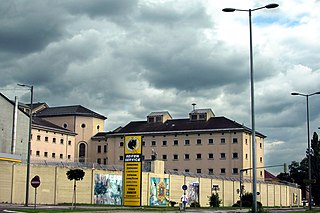
Graz-Karlau Prison is located in Gries, the 5th district of the city of Graz, capital of the Austrian state of Styria. With a capacity of 552 inmates, Graz-Karlau is the third-largest prison in Austria.

Anatole Deibler was a French executioner from Rennes. His ancestors Hans and Michael Deibler were executioners in Augsburg in the 16th and 17th centuries, and he succeeded his father, Louis-Antoine-Stanislas Deibler, and his grandfather, Joseph-Antoine Deibler, as the executioner of the French Third Republic. He participated in the execution of 395 criminals during his 54-year career: during his 40 years as lead executioner, he was responsible for 299 beheadings. In the early 20th century, Deibler was deemed the "most hated man in France". There was more prejudice against him than American or English executioners because of a superstition that a French headsman had an evil eye that brought death or disaster to whoever caught glimpse. Deibler was in danger of being mobbed wherever he went and would often conceal his identity. At the time, his annual salary was around 6,000 francs while an additional 8,000 francs was paid for upkeep of the guillotine and 10 francs were paid for every day the guillotine was in operation. It is estimated Diebler's net annual income was around 30,000 francs . He is considered one of the most famous French executioners. This is due to the fact that most of his executions were public and were widely reported by the media. The advent of the camera made him somewhat of a celebrity. Deibler died suddenly from a heart attack at a metro station while on his way to his 300th execution.
Capital punishment in Lesotho is legal. However, despite not having any official death penalty moratorium in place, the country has not carried out any executions since the 1990s and is therefore considered de facto abolitionist.
The job of executioner had become part-time. Henri Desfourneaux's two assistants also worked as a butcher and a hairdresser — fitting sidelines to their decapitating functions. The last guillotine operator, Marcel Chevalier, incumbent from ...